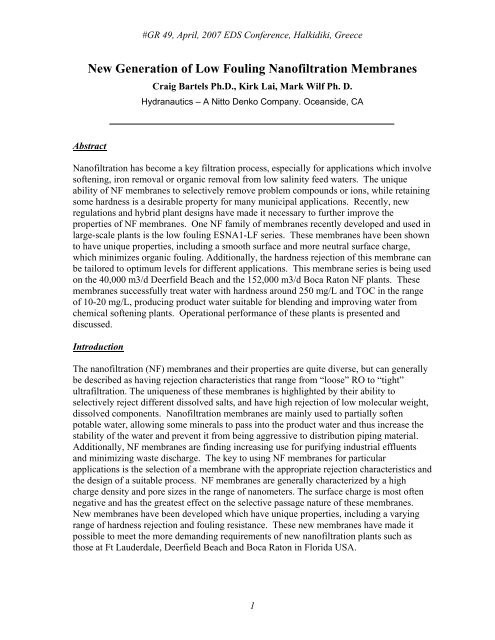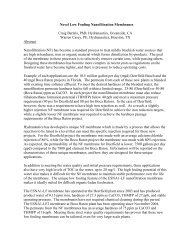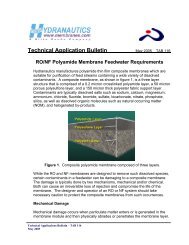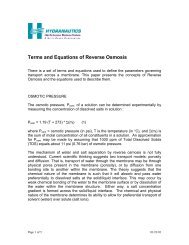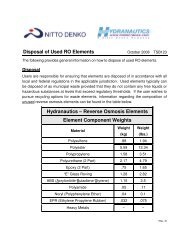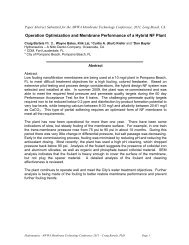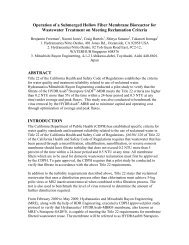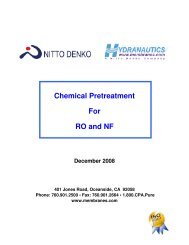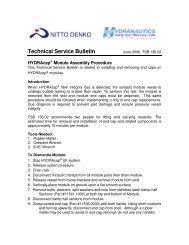New Generation of Low Fouling Nanofiltration ... - Hydranautics
New Generation of Low Fouling Nanofiltration ... - Hydranautics
New Generation of Low Fouling Nanofiltration ... - Hydranautics
You also want an ePaper? Increase the reach of your titles
YUMPU automatically turns print PDFs into web optimized ePapers that Google loves.
#GR 49, April, 2007 EDS Conference, Halkidiki, Greece<br />
<strong>New</strong> <strong>Generation</strong> <strong>of</strong> <strong>Low</strong> <strong>Fouling</strong> Nan<strong>of</strong>iltration Membranes<br />
Abstract<br />
Craig Bartels Ph.D., Kirk Lai, Mark Wilf Ph. D.<br />
<strong>Hydranautics</strong> – A Nitto Denko Company. Oceanside, CA<br />
Nan<strong>of</strong>iltration has become a key filtration process, especially for applications which involve<br />
s<strong>of</strong>tening, iron removal or organic removal from low salinity feed waters. The unique<br />
ability <strong>of</strong> NF membranes to selectively remove problem compounds or ions, while retaining<br />
some hardness is a desirable property for many municipal applications. Recently, new<br />
regulations and hybrid plant designs have made it necessary to further improve the<br />
properties <strong>of</strong> NF membranes. One NF family <strong>of</strong> membranes recently developed and used in<br />
large-scale plants is the low fouling ESNA1-LF series. These membranes have been shown<br />
to have unique properties, including a smooth surface and more neutral surface charge,<br />
which minimizes organic fouling. Additionally, the hardness rejection <strong>of</strong> this membrane can<br />
be tailored to optimum levels for different applications. This membrane series is being used<br />
on the 40,000 m3/d Deerfield Beach and the 152,000 m3/d Boca Raton NF plants. These<br />
membranes successfully treat water with hardness around 250 mg/L and TOC in the range<br />
<strong>of</strong> 10-20 mg/L, producing product water suitable for blending and improving water from<br />
chemical s<strong>of</strong>tening plants. Operational performance <strong>of</strong> these plants is presented and<br />
discussed.<br />
Introduction<br />
The nan<strong>of</strong>iltration (NF) membranes and their properties are quite diverse, but can generally<br />
be described as having rejection characteristics that range from “loose” RO to “tight”<br />
ultrafiltration. The uniqueness <strong>of</strong> these membranes is highlighted by their ability to<br />
selectively reject different dissolved salts, and have high rejection <strong>of</strong> low molecular weight,<br />
dissolved components. Nan<strong>of</strong>iltration membranes are mainly used to partially s<strong>of</strong>ten<br />
potable water, allowing some minerals to pass into the product water and thus increase the<br />
stability <strong>of</strong> the water and prevent it from being aggressive to distribution piping material.<br />
Additionally, NF membranes are finding increasing use for purifying industrial effluents<br />
and minimizing waste discharge. The key to using NF membranes for particular<br />
applications is the selection <strong>of</strong> a membrane with the appropriate rejection characteristics and<br />
the design <strong>of</strong> a suitable process. NF membranes are generally characterized by a high<br />
charge density and pore sizes in the range <strong>of</strong> nanometers. The surface charge is most <strong>of</strong>ten<br />
negative and has the greatest effect on the selective passage nature <strong>of</strong> these membranes.<br />
<strong>New</strong> membranes have been developed which have unique properties, including a varying<br />
range <strong>of</strong> hardness rejection and fouling resistance. These new membranes have made it<br />
possible to meet the more demanding requirements <strong>of</strong> new nan<strong>of</strong>iltration plants such as<br />
those at Ft Lauderdale, Deerfield Beach and Boca Raton in Florida USA.<br />
1
#GR 49, April, 2007 EDS Conference, Halkidiki, Greece<br />
The design <strong>of</strong> a NF system can <strong>of</strong>ten be more complex than a RO system. Because the<br />
required transmembrane pressure is so low, a system design that will result in balanced flux<br />
throughout the array is difficult to achieve. One common approach is to design NF systems<br />
with multiple element types. So called “hybrid” designs can help more finely control flow<br />
in the NF system. In other cases, plant operators prefer to have one membrane type to more<br />
easily manage the membrane inventory. Only if one type suitable membrane cannot be<br />
found, will designers use the hybrid design.<br />
Also, many NF plants are treating more difficult source waters (1), such as surface waters or<br />
ground waters under the influence. These can contain high levels <strong>of</strong> organic compounds<br />
which must be removed to achieve potable water quality targets. In some cases the organic<br />
compounds can foul the NF membrane, especially when the system is run at high recovery<br />
rates. This adds another complication because membrane fouling can cause a change <strong>of</strong><br />
rejection selectivity and/or reduction <strong>of</strong> membrane permeability that could affect both the<br />
water quality and operating cost due to increased energy requirement and higher<br />
consumption <strong>of</strong> chemicals needed for stabilization <strong>of</strong> permeate.<br />
As previously stated, the rejection characteristics <strong>of</strong> new NF membranes can be tailored to<br />
meet a variety <strong>of</strong> hardness rejection values. Additionally, this new class <strong>of</strong> NF membranes<br />
has properties which make them more resistant to fouling by organic compounds.<br />
Membrane Properties <strong>of</strong> <strong>New</strong> NF Membranes<br />
<strong>New</strong> NF membranes have been developed which can be tailored to have a range <strong>of</strong> hardness<br />
rejection. These membranes are composite polyamide type, similar to existing RO<br />
membranes, but are chemically treated to adjust the hardness rejection. This treatment also<br />
imparts fouling resistance.<br />
A series <strong>of</strong> nan<strong>of</strong>iltration membranes whichh were prepared with increasing treatments and<br />
designated ESNA1-LF, LF2 and LF3. The relative performances <strong>of</strong> these membranes are<br />
listed in Table 1.<br />
Table 1 Nan<strong>of</strong>iltration product performance comparison<br />
Product Element Area Nominal Flow<br />
Nominal<br />
Rejection<br />
(ft2) (m2) (gpd) (m3/d) (%)<br />
ESNA1-LF 400 37.2 8200 31.1 89<br />
ESNA1-LF2 400 37.2 10500 39.8 86<br />
ESNA1-LF3 400 37.2 7200 27.3 90<br />
Test Conditions: 500 mg/L <strong>of</strong> CaCl2, 75 psi, 25 C<br />
As the hardness rejection is parallel to the nominal rejection <strong>of</strong> the membrane it can be seen,<br />
the LF2 has a lower hardness rejection and higher permeability than ESNA1-LF, while<br />
ESNA1-LF3 has higher rejection and lower permeability than ESNA1-LF. This trade-<strong>of</strong>f<br />
between flux and rejection is typical for membranes, but these membranes are unique due to<br />
2
#GR 49, April, 2007 EDS Conference, Halkidiki, Greece<br />
the fine control <strong>of</strong> trade-<strong>of</strong>f that can be achieved. Figure 1 shows the relative rejection <strong>of</strong><br />
various ions when LF and LF2 are used to treat a low salinity surface water. It can be seen<br />
that the actual hardness rejection is 93% versus 83%. This feature is important for many<br />
new plants which want a controlled amount <strong>of</strong> hardness in the water. This requires the<br />
hardness rejection to have both a minimum and a maximum value. The other important ion<br />
is iron, since many well waters have high values <strong>of</strong> iron that must be reduced. Again, LF<br />
membrane has higher rejection <strong>of</strong> iron, but lower permeability than ESNA1-LF2.<br />
The other feature <strong>of</strong> this membrane is the low fouling nature. This can be attributed to two<br />
features – the smoothness <strong>of</strong> the surface and the near neutral surface charge. Figure 2<br />
shows the Scanning Electron Microscope (SEM) image <strong>of</strong> the ESNA1-LF membrane<br />
compared to the ESPA3 loose polyamide RO membrane.<br />
Figure 1 Comparison <strong>of</strong> ion rejection values for ESNA1-LF and LF2<br />
Rejection (%)<br />
100<br />
95<br />
90<br />
85<br />
80<br />
75<br />
70<br />
65<br />
60<br />
55<br />
50<br />
Rejection ESNA1-LF (%)<br />
Rejection ESNA1-LF2 (%)<br />
Na+ Ca++ Mg++ Fe++ Cl- SO4= SiO2 TOC<br />
Species<br />
The lower charge <strong>of</strong> the ESNA1-LF membrane can be seen in Figure 3. The figure shows<br />
the Zeta Potential <strong>of</strong> the membrane surface measured as a function <strong>of</strong> the feed pH. It can be<br />
seen that the traditional nan<strong>of</strong>iltration membrane has a very strong negative charge at<br />
neutral pH values. In contrast the low fouling RO membrane, LFC1, has a slight negative<br />
charge at these pH values. Similarly, the ESNA1-LF membrane has a slight, or near neutral<br />
surface charge. This minimal surface charge minimizes the interaction with some organic<br />
compounds.<br />
3
#GR 49, April, 2007 EDS Conference, Halkidiki, Greece<br />
Figure 2 SEM image <strong>of</strong> the surface <strong>of</strong> the ESNA1-LF membrane compared to the ESPA3<br />
membrane<br />
Figure 3 Surface charge <strong>of</strong> ESNA1-LF and other membranes<br />
ζ Potential<br />
10<br />
0<br />
-10<br />
-20<br />
-30<br />
-40<br />
-50<br />
ESNA1-LF<br />
ESNA1<br />
LFC1<br />
ESNA1-LF Surface<br />
2 3 4 5 6 7 8 9 10<br />
pH<br />
Nan<strong>of</strong>iltration System Requirements<br />
Due to more complex drinking water requirements, the performance requirements for NF<br />
membranes have become more difficult. Examples <strong>of</strong> this are seen in plants that treat<br />
groundwater in Florida, USA. Feedwater and product water requirements for two such<br />
plants, Deerfield (2) and Boca Raton (3), are shown in Table 2. Each has a different<br />
hardness range target. Because <strong>of</strong> the high level <strong>of</strong> iron in the Deerfield water, 1.5 ppm, a<br />
higher rejection membrane is needed compared to Boca, which only has 0.3 ppm. The<br />
other important requirement is that the membranes should have high rejection <strong>of</strong> organics<br />
that form disinfection by-products. The requirement is that trihalomethane formation<br />
potential (THMFP) and haloacetic acid (HAAFP) should be below 42 and 30 ug/L,<br />
respectively.<br />
4<br />
ESPA3 Surface
#GR 49, April, 2007 EDS Conference, Halkidiki, Greece<br />
Table 2 Feedwater and Product Water for Select Florida NF Applications<br />
Species Units<br />
Feedwater Composition Permeate Requirement<br />
Deerfield<br />
Boca<br />
Raton<br />
Ft Lauderdale<br />
5<br />
Deerfield<br />
Boca<br />
Raton<br />
Ft Lauderdale<br />
Total<br />
Hardness<br />
mg/L<br />
CaCO3<br />
250 265 270 26-82.5 50-80
#GR 49, April, 2007 EDS Conference, Halkidiki, Greece<br />
For the Deerfield Beach project, the ESNA1-LF gave high enough rejection to reduce iron<br />
and disinfection by-products to acceptable values, while controlling hardness in the<br />
acceptable range. At Boca Raton pilot, the ESNA1-LF2 was selected because the iron<br />
rejection requirement was much easier to achieve, while it was required to have less<br />
hardness rejection (see Table 2).<br />
The pretreatment to the nan<strong>of</strong>iltration system at Deerfield (Figure 5) consists <strong>of</strong> sulfuric<br />
acid addition, scale inhibitor injection, followed by 5 micron cartridge filtration (2). This is<br />
the typical pretreatment to almost all <strong>of</strong> the reverse osmosis and nan<strong>of</strong>iltration systems in<br />
Florida that operate on un-aerated well water supplies. The permeate is sent to a degassifier<br />
for carbon dioxide (and sometimes H2S) reduction and later blended with lime s<strong>of</strong>tened<br />
effluent. The nan<strong>of</strong>iltration concentrate is directed to a pressurized sanitary main.<br />
Figure 5 Deerfield Beach System Design<br />
769 gpm 322 gpm<br />
5 um Cart Filters (175 m3/hr) (73 m3/hr)<br />
Well Waste<br />
2146 gpm 1375 gpm 447 gpm<br />
(488 m3/hr) (313 m3/hr) (102 m3/hr)<br />
Antiscalant Product Water<br />
25 C Acid RO System 1823 gpm<br />
482 ppm TDS ESNA1-LF (414 m3/hr)<br />
250 ppm Hardness 85% Recovery Total<br />
285 ppm HCO3 5 Trains, 2 Stages 10.5 mgd<br />
1.5 ppm Fe 48 Vess x 24 Vess x 7 Elem (40,000 m3/d)<br />
20 ppm TOC 13 gfd (22 lmh) Flux<br />
For the Boca Raton project, the pretreatment included a multimedia filter, and no antiscalant<br />
or acid was used (3). Typically, this would not be possible because <strong>of</strong> the high scaling<br />
potential <strong>of</strong> the CaCO3. The LSI <strong>of</strong> the concentrate is expected to be around 1.9. However,<br />
pilot testing demonstrated that stable operation could be achieved without acid or<br />
antiscalant. Apparently, this is due to the high level <strong>of</strong> organics in the well water acting as a<br />
natural scale inhibitor. The design is shown in Figure 6.<br />
The NF product water specifications were selected to be able to blend with water from the<br />
lime s<strong>of</strong>teners already operating at these sites. The resulting blend is designed to meet the<br />
product water quality requirements. In particular, the NF membrane system will greatly<br />
reduce TOC in the finished water compared to lime s<strong>of</strong>teners. Normally, the municipalities<br />
may use up to 30 ppm <strong>of</strong> chlorine to reduce the color. With the use <strong>of</strong> NF membranes, the<br />
chlorine demand <strong>of</strong> the water is significantly less. Also, the lower TOC and chlorine<br />
concentration will produce much less disinfection by-products, which is the goal <strong>of</strong> the<br />
hybrid design.<br />
6
#GR 49, April, 2007 EDS Conference, Halkidiki, Greece<br />
Figure 6 Boca Raton NF Plant System Design<br />
(258 m3/hr) (102 m3/hr)<br />
Well Media<br />
Filter<br />
5 um Cart Filters 1136 gpm 450 gpm<br />
Waste<br />
LSI = 1.9<br />
3003 gpm 1867 gpm 686 gpm<br />
(683 m3/hr) (424 m3/hr) (156 m3/hr)<br />
Product Water<br />
25 C RO System 2553 gpm<br />
466 ppm TDS No Antiscalant ESNA1-LF2 (580 m3/hr)<br />
265 ppm Hardness NO Acid 85% Recovery Total<br />
265 ppm HCO3 10 Trains, 2 Stages 40 mgd<br />
0.3 ppm Fe 72 Vess x 36 Vess x 7 Elem (152,000 m3/d)<br />
12 ppm TOC 12.2 gfd (20.7 lmh) Flux<br />
Commercial Plant Operation<br />
The 40,000 m3/d (10.5 mgd) Deerfield Beach nan<strong>of</strong>iltration system consists <strong>of</strong> five units,<br />
each with a capacity <strong>of</strong> 9,900 m3/d (2.625 mgd). Only four units are required to meet the<br />
total demand with the fifth unit in a standby mode. Each unit operates at 85% recovery and<br />
is a 48-24 two-stage array <strong>of</strong> pressure vessels. Each pressure vessel contains seven spiral<br />
wound nan<strong>of</strong>iltration elements for a total <strong>of</strong> 504 each ESNA1-LF nan<strong>of</strong>iltration elements<br />
per unit. A total <strong>of</strong> 2,520 elements were supplied for the project. The units operate at an<br />
average flux <strong>of</strong> 22 lmh (13 gfd).<br />
At Deerfield Beach all five units started operation in November and December <strong>of</strong> 2003 (3).<br />
All five units were within the specified ranges at startup and continue to meet specifications<br />
3 years after startup. As can be seen in Table 3, the permeate quality has easily made the<br />
specification for iron, producing 0.1 ppm Fe in the product. The system hardness rejection<br />
averages 95% and the total trihalomethane and haloacetic formation potentials <strong>of</strong> the<br />
permeate are well below limits. The average flux decline <strong>of</strong> all 5 units is approximately<br />
10% after 1 ½ years <strong>of</strong> service (Figure 7). As <strong>of</strong> late 2006, no unit has required a cleaning<br />
based on flux decline even though the feed TOC levels in feed water have been measured as<br />
high as 36 mg/l. Only the normalized trans-element pressure drop has increased and<br />
indications are that cleaning will soon be needed.<br />
The NF membrane plant has achieved its objectives by greatly lowering THM and HAA<br />
values in the product water. THM values had typically been 25-90 ug/l and THAA values<br />
were in the range <strong>of</strong> 60-90 ug/L. The regulatory limits for both <strong>of</strong> these were 80 and 60<br />
ug/L respectively. With a membrane to s<strong>of</strong>tener blend <strong>of</strong> 60:40, the product water easily<br />
met the regulatory limits.<br />
In regards to cost, the use <strong>of</strong> the low foul NF membranes allowed the plant to operate at pH<br />
6.5 instead <strong>of</strong> the original design <strong>of</strong> 6.2. In addition the plant has saved money by not<br />
performing any chemical cleanings to date.<br />
7
#GR 49, April, 2007 EDS Conference, Halkidiki, Greece<br />
Table 3 Florida feedwater composition and NF permeate composition<br />
Species Units<br />
Feedwater Composition Actual NF Permeate<br />
Deerfield<br />
Boca<br />
Raton<br />
Ft Lauderdale<br />
8<br />
Deerfield<br />
Boca<br />
Raton<br />
Ft Lauderdale<br />
pilot<br />
Total<br />
Hardness<br />
mg/L<br />
CaCO3<br />
250 266 270 27.5 50-80 15<br />
Iron<br />
(Dissolved)<br />
mg/L 1.5 0.3 2 0.14 0.04 0.1<br />
HCO3 mg/L 285 265 269 26 74 20<br />
TDS mg/L 482 466 500 61 137<br />
TOC mg/L 20 11.7 11
#GR 49, April, 2007 EDS Conference, Halkidiki, Greece<br />
resulted in significant cost savings. In addition the trans membrane pressure (feed minus<br />
permeate) was 5 bar (73 psi), which was less than the specified 5.5 bar (80 psi). The plant<br />
also met all the permeate water requirements (Table 3).<br />
The performance <strong>of</strong> one train from the Boca plant is given in Figure 8. It shows that this<br />
plant has reasonable performance over the past two years, meeting all water quality<br />
requirements and running at a pressure <strong>of</strong> less than 90 psi as required. However, there has<br />
been some fouling. The normalized permeate flow has dropped 34% and the dP has<br />
increased 50%. Some high pH cleanings have been performed to remove organic material,<br />
but these have not significantly restored original values. Initial analysis indicated the<br />
presence <strong>of</strong> calcium phosphate deposits. Acid cleaning was effective to remove this and<br />
restore flow to a test element.<br />
Figure 8 Performance <strong>of</strong> one train at the Boca Raton Plant<br />
Perm Flow (m3/hr)<br />
600<br />
500<br />
400<br />
300<br />
200<br />
100<br />
0<br />
2-Jan-05<br />
Normalized Data<br />
2-Mar-05<br />
Normalized Flow<br />
Normalized Salt Passage<br />
Normalized Press Drop<br />
2-May-05<br />
2-Jul-05<br />
2-Sep-05<br />
2-Nov-05<br />
2-Jan-06<br />
9<br />
2-Mar-06<br />
2-May-06<br />
2-Jul-06<br />
2-Sep-06<br />
2-Nov-06<br />
A more detailed study has been done at the Boca Raton Plant using a single element test<br />
unit. A variety <strong>of</strong> chemicals are being tested to select the most effective cleaning regime.<br />
When elements were removed from the system, it was evident that the tail <strong>of</strong> the system had<br />
signs <strong>of</strong> salt crystals. This is a sign <strong>of</strong> scale formation. Testing <strong>of</strong> individual elements<br />
revealed that the last two elements <strong>of</strong> the second stage had lost a significant amount <strong>of</strong> flow<br />
(Table 4). Acid cleaning was shown to restore the original flow and rejection <strong>of</strong> the<br />
element. This further supports the analysis that scaling has occurred. Cleaning <strong>of</strong> the entire<br />
plant is planned next.<br />
Despite these issues, the plant has performed extremely well. An early analysis was done<br />
which indicated that the avoidance <strong>of</strong> acid and antiscalant addition, as well as the caustic<br />
that would be need for post-treatment results in a savings <strong>of</strong> $927,000 per year. The lower<br />
20.0<br />
18.0<br />
16.0<br />
14.0<br />
12.0<br />
10.0<br />
8.0<br />
6.0<br />
4.0<br />
2.0<br />
0.0<br />
Salt Passage (%) & Press Drop (bar)
#GR 49, April, 2007 EDS Conference, Halkidiki, Greece<br />
than expected feed pressure also resulted in a $48,000 per year savings compared to the<br />
original design.<br />
Table 4 Effect <strong>of</strong> Element Cleaning Study at Boca Raton Plant<br />
Vessel<br />
Stg 2<br />
Vessel<br />
Position<br />
Serial #<br />
Element Flow at a normalized TMP <strong>of</strong> 4.69 bar<br />
Factory<br />
Test<br />
(m3/hr)<br />
Preclean<br />
(m3/hr)<br />
10<br />
Post low<br />
pH clean<br />
(m3/hr)<br />
Post high<br />
pH clean<br />
(m3/hr)<br />
108 7 A916827 1957 914 2111 2235<br />
99 1 A913466 2193 0 1787 2269<br />
99 3 A917052 2108 0 2303 2535<br />
99 4 A915286 1576 0 1433 1899<br />
99 7 A916885 1951 0 2203 2493<br />
The analysis <strong>of</strong> the plant performance and the presence <strong>of</strong> scale on the tail elements<br />
indicates that the natural organics present in the water are not sufficient to fully control<br />
scaling. However, the fact that the plant ran this long without acid cleaning indicates that<br />
the natural organics have controlled scaling to some degree, but will need to be augmented<br />
with acid or antiscalant addition similar to the Deerfield plant.<br />
Finally, pilot testing was recently carried out for the 45,500 m3/d (12 mgd) Ft Lauderdale<br />
plant. As seen in Table 2, the permeate quality targets for this project were slightly<br />
different than the other plants in that the iron was projected to be even higher and there was<br />
a minimum value <strong>of</strong> alkalinity that was allowed. Initially, ESPA4 RO membrane was<br />
selected to meet the requirements; however, the permeate alkalinity was below the 15 ppm<br />
limit. Ultimately, designers elected to use ESPA4 in the first stage, while the second stage<br />
7 element vessel had 4 ESPA4 in the front position and 3 ESNA1-LF2 elements in the back<br />
position. This hybrid design met the permeate water quality targets, as shown in Table 3.<br />
Conclusion<br />
The operation <strong>of</strong> these NF plants indicates that the new series <strong>of</strong> low fouling NF membranes<br />
are able to treat these high organic laden feedwaters with stable performance. Due to the<br />
more stringent water quality requirements and the hybrid design with existing s<strong>of</strong>tener<br />
technology, membranes with variable hardness rejection are required. The ESNA1-LF<br />
series <strong>of</strong> membranes can be tailored to a fine degree to meet these requirements. These NF<br />
membranes also give high rejection <strong>of</strong> organic compounds to allow the plants to meet the<br />
disinfection by-product reduction requirements. For complex waters like these, it is<br />
important to pilot test to select the optimum membrane and system design. The results at<br />
the Boca Raton plant show the surprising ability to run with very high LSI, without using<br />
antiscalant. This is believed to be due to the antiscalant properties <strong>of</strong> the natural organic<br />
matter. Although the performance <strong>of</strong> this plant has not equaled the stable results <strong>of</strong> the one<br />
that does add acid and antiscalant, the performance is reasonable, and can be further<br />
optimized to find the lowest cost operating point.
References<br />
#GR 49, April, 2007 EDS Conference, Halkidiki, Greece<br />
1. Keifer, C., Jackson, H.E., “Advantages <strong>of</strong> <strong>New</strong> <strong>Low</strong> <strong>Fouling</strong> Nan<strong>of</strong>iltration<br />
Membranes versus a Hybrid Membrane Design for Deerfield Beach”, Proc. AWWA<br />
National Meeting in <strong>New</strong> Orleans, LA, June 16-20, 2002.<br />
2. C.A. Kiefer, W.M. Miller, J.L. Leone, W.B. Suratt, “Optimizing <strong>New</strong> <strong>Low</strong> <strong>Fouling</strong><br />
Nan<strong>of</strong>iltration membrane performance for Deerfield Beach”, 2003 AWWA<br />
Membrane Technology Conference, Atlanta GA.<br />
3. F. Brinson, C.A. Kiefer, W. B.Suratt, C. Helfrich, W. Casey, H. Said, “Process<br />
optimization during the first year <strong>of</strong> operation <strong>of</strong> a 40-mgd nan<strong>of</strong>iltration plant.”<br />
AWWA 2005 Annual Meeting, San Francisco, CA.<br />
11


